Original article by Peter J. Koehler published 9 February 2015 in World Neurology Vol 30 No.1
 |
Figure 1. Title page of the History and Memories of the Society for the Rescue of Drowned Persons (1780). |
Curious Practices Arise from Fear of Being Buried Alive
Coma has been a phenomenon of interest for physicians as well as laypeople through the ages and was associated chiefly with stroke ("apoplexy" ) and trauma1. One chapter in the history of coma has two extraordinary perspectives, notably coma following drowning and the fear of being buried alive, which played a role particularly during the late 18th century.
Drowning Rescue and Resuscitation
A considerable number of books on comatose persons, usually drowning victims, often referred to in the titles as "apparently dead," appeared during the 18th century. These books were published when the first societies for the resuscitation of drowning people had been established. It is of no surprise that the first of these societies was founded in the Netherlands (1767), notably the Amsterdam Society for the Rescue of Drowning Persons (Maatschappij tot Redding van Drenkelingen). Due to the many canals, drowning was a frequent event in Holland. The society paid premiums for saved drowning persons and thus in the 1780 publication (Fig. 1), it is reported that "73 premiums had been distributed to good and indefatigable surgeons and other persons" in the years 1778-9. The lifesavers could choose between six gold ducats or a gold medal.
Drowning persons were supposed to be brought inside a house, airways inspected, wet clothes removed, warmed up by rubbing with woollen clothes, and administered tobacco smoke fumigation by rectum. Following this warming up, bleeding could be applied from the arm or neck, but not too superfluous. Only if signs of swallowing acts were observed, not earlier, some hard liquor could be poured down in the mouth and the rapid spirit of ammonia salt kept under the nose. If this did not work, the drowning person should be laid in a preheated bed, accompanied by a naked person who provided natural heat. The book contains short histories of failed resuscitations and longer cases histories of successful ones.
A case history (March 27, 1778, 10;30 a.m., Noordwaddingsveen): a 5-year old boy, Jan van Someren, was missed for half an hour and found in the water, apparently dead, by his parents Cornelis van Someren and Aagje Joosten Robberts. A surgeon, Pieter de Nick, was sent for, the child brought inside and warmed up. The usual resuscitation methods were applied and only after a prolonged period (one hour) the blue lips disappeared and he began to cry. He was laid in a warm bed with another person and after some time he started to speak. He recovered completely the next day and Pieter de Nick received the gold medal.
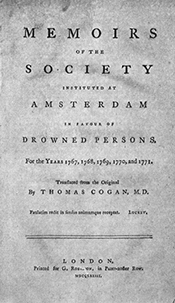 |
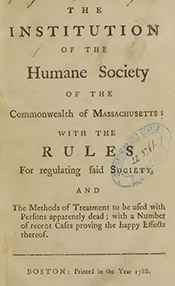 |
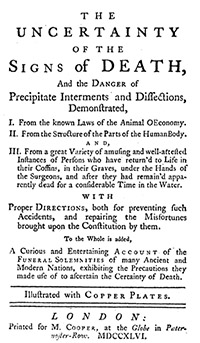 |
Figure 2. English translation of the Amsterdam Society by Thomas Cogan (1773). |
Figure 3. American Society (Boston, 1788). |
Figure 4. The Uncertainty of the Sign of Death (1746). |
The Dutch example was soon followed by several other countries. In 1774, the English society was founded by physicians William Hawes and Thomas Cogan, the latter becoming interested after a visit to Amsterdam (Fig. 2). An American society was founded in 1787, notably The Institution of the Humane Society of the Commonwealth of Massachusetts (Fig. 3)2-5. Although John Hunter (1776) suggested cessation of respiration was the primary cause of death and cardiac arrest secondary, and also wrote about ventilation, it would be more than a century before it was routinely applied (see also 6).
Buried Alive
 |
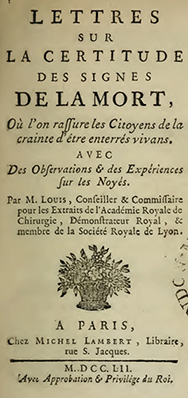 |
Figure 5. Fear of being buried alive (1746). |
Figure 6. French book on Certainty of Signs of Death by Louis (1752). |
Next to coma in drowning persons, there was another aspect of apparently dead, notably a great fear for being buried alive, a.o. appearing from the titles of the publications, for instance, the book The uncertainty of the signs of death, and the danger of precipitate interments and dissections … with proper directions, both for preventing such accidents, and repairing the misfortunes brought upon the constitution by them. The book contains chapter titles such as: "A woman, falling into a syncope, occasioned by a violent fit of passion, suppos'd to be dead, and put into a coffin" and "Precautions to be us'd in order to recover those who have been drown'd or buried alive" (Figs. 4 and 5)7. Another example is the French Lettres sur la certitude des signes de la mort. Où l'on rassure les Citoyens de la crainte d'êtres enterrés vivans (Fig. 6)8.
The English physician John Fothergill suggested that in some situations it might be profitable to "distend the lungs with air," in particular in "sudden Deaths from some invisible Cause; Apoplexies, Fits of various Kinds, as Hysterics, Syncope's, and many other Disorders, wherein, without any obvious Prae-indisposition, Persons in a Moment sink down and expire" (Fig. 7)9. Next to artificial ventilation, the use of electric shock, not unexpected in this age of medical electricity, was recommended10.
 |
Figure 7. John Fothergill's publication (1744). |
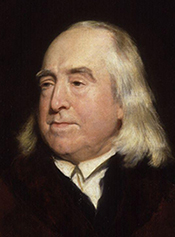 |
Figure 8. Jeremy Bentham, English philosopher and jurist. |
The fear of being buried alive led to curious practices including the one advised by the English lawyer and philosopher Jeremy Bentham to nail a wooden pin through the brain or heart for the prevention of interment of apparently dead ("require that a spike of appointed length, kept for the purpose, be run either through the heart, or into the brain, through the secket of the eye" ) (Fig. 8)11. The Danish-born French anatomist Jacob Winslow wrote a thesis about the uncertainties of the signs of death (translated and augmented by Jacques-Jean Bruhier), which contains stories of persons, who were buried almost too early. Huston was critical about Winslow's and Bruhier's "fabulous stories of recovery" 12. Winslow himself would have escaped a premature burial two times and concluded that putrefaction is the only real sign of death13. He referred to the well-known (but controversial) case, autopsied by the 16th-century physician and anatomist Andreas Vesalius, who appeared to be alive, after which Vesalius was prosecuted for murder12. The king of Spain changed the sentence into a voyage to the Holy Land.
Later, even Charles Dickens was concerned about the apparent dead, as can be read in a contribution in his weekly journal, in which he warned against prematurely buried persons while still alive14. Coma, in drowning persons as well as the fear of being buried in such condition, was an issue among physicians as well as laypersons for centuries in many countries.
Dr. Koehler is neurologist at Atrium Medical Centre, Heerlen, The Netherlands. Visit his website at www.neurohistory.nl.
This article was adapted from a section of Koehler PJ. The history of coma. In: Boes CJ (ed.). The History of Certain Disorders of the Nervous System. American Academy of Neurology, Philadelphia, 2014.
References
- Koehler PJ, Wijdicks EFM. Historical study of coma: looking back through medical and neurological texts. Brain 2008;131:877-889
- Historie en gedenkschriften van de maatschappij tot redding van drenkelingen. Amsterdam, Meijer, 1768.
- Johnson A. A short account of a society at Amsterdam instituted in the year 1767 for the recovery of drowned persons with observations shewing that the utility and advantage that would accrue tot Great Britain from a similar institution etc. London, John Nource et al., 1778.
- Hawes W. The transactions of the Royal Human Society. London, Nichols, 1796.
- The Institution of the Humane Society of the Commonwealth of Massachusetts: With the Rules for Regulating Said Society, and the Methods of Treatment to be Used with Persons Apparently Dead: With a Number of Recent Cases Proving the Happy Effects Thereof. Boston, 1788.
- Payne JP. On the resuscitation of the apparently dead. Ann R Coll Surg Engl. 1969;45:98–107
- The uncertainty of the signs of death, and the danger of precipitate interments and dissections…with proper directions, both for preventing such accidents, and repairing the misfortunes brought upon the constitution by them. London, Cooper, 1746.
- Louis M. Lettres sur la certitude des signes de la mort. O๠l'on rassure les Citoyens de la crainte d'àªtres enterrés vivans. Paris, Lambert, 1752.
- Fothergill J. Observations on a Case Published in the last Volume of the Medical Essays, &c. "of recovering a Man dead in Appearance, by distending the Lungs with Air. Printed at Edinburgh, 1744" in The Works of John Fothergill, M. D . . . London, 1784. [Ed. J. C. Lettsom]
- Kite, C. An Essay on the Recovery of the Apparently Dead. London, Dilly, 1788.
- Bentham J. Works vol. 6. Edinburgh, Tait, 1843, p.571.
- Huston KG. Resuscitation. An historical perspective. Wood Library – Museum, Park Ridge, Illinois, 1976, p.2.
- Winslow JB. Dissertation sur l'incertitude des signes de la mort et l'abus des enterremens, & embaumens précipités. Transl and commented by Bruhier JJ. Paris, Morel et al. 1742.
- Dickens, C. "Apparent Death" in All the Year Round, New Series, Vol.II, No. 31 (Saturday, July 3, 1869), pp. 109-114.








